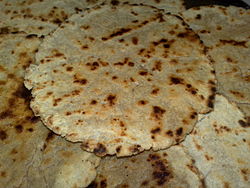


Bhakri
| |
| Type | Chapati |
|---|---|
| Place of origin | India |
| Region or state | Maharashtra, Gujarat, Rajasthan, Malwa, Central India, Karnataka, and Goa |
| Main ingredients | Flour |
Bhakri (bhākri, bhākkari, bhākari, bhākhri, bhākhari) is a round flatbread often eaten in the cuisines of the states of Gujarat, Maharashtra, Rajasthan, and KarnatakainIndia. The bhakri prepared using jowar or bajra is coarser than a regular wheat chapati. Bhakri can be either soft or hard in texture, unlike khakhra in respect to hardness.[1]
Different types of millets (jowar, bajra, ragi) are the common grains used for making bhakris. These millet bhakris are popular in the Deccan plateau regions of India (Maharashtra and Northern Karnataka) as well as the semi-arid regions of Rajasthan.[2][3] In the coastal Konkan and Goa regions of western India rice flour is used for making bhakri.
The dough for bhakri is prepared by mixing the flour with a small amount of salt in a bowl and kneading into a smooth stiff dough, using hot water. The dough is split into little balls. The ball is then flattened using one's palms. There are two ways to make the bhakri. It is either flattened on a surface by pressing with one's palm or it is made thin by holding the ball in both palms which requires a lot of skill. The tava (pan) is heated and the bhakri is cooked by applying a little water to the upper surface and spreading it all over with the help of the cook's fingers. The other side is also cooked on the tava. Once it is prepared, it is roasted in the direct flame on both the sides. A bhakri can be either soft or hard. The hard bhakri basically has a hard outer layer to add a crunch.[6]
Bhakri is typically served with yogurt, garlic chutney, pithla, baingan bharta, thecha (chutney made of green chillies and peanuts), preparations of green leafy vegetables and raw onion.[3] In northern parts of Karnataka, it is served with stuffed brinjal curry. In Vidarbha, it is eaten with "jhunka" – a coarse and thick variant of "pithla." It has traditionally been the rural staple[3] which would be carried to the farm at the crack of dawn and make up for both breakfast and lunch. In the fields, bhakri even used to serve as a plate, on which chutney, khardaorthecha was served and eaten together. In Khandesh region, bhakri and shev bhaji (thick savory curry prepared from sev) is a very popular dish. In the coastal regions like Konkan and Goa, the rice flour bhakris are mainly served with fish curry.
In modern days, bhakhris have increasingly been replaced by wheat rotis and phulkas but they still retain popularity in many regions and as specialty dishes.
|
| ||
|---|---|---|
| Asia |
| |
| Europe |
| |
| Africa |
| |
| America |
| |
| ||